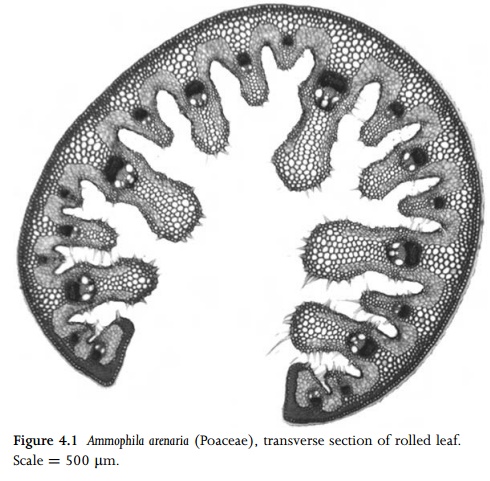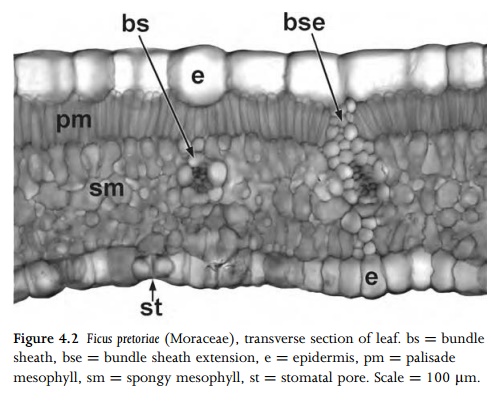Chapter: Anatomy of Flowering Plants: An Introduction to Structure and Development : Leaf
Leaf Morphology and Anatomy
Leaf Morphology and Anatomy
Angiosperm
leaves display much morphological and anatomical diversity. Mature leaves of
monocots are typically narrow and consist of a linear lamina with parallel
venation and a leaf base that ensheathes the stem. This contrasts with the
typical leaf of eudicots and magnoliids, which has a well-defined petiole and
elliptical blade (lamina) with reticulate venation. However, exceptions and
transitional forms are common; for example, leaves of some monocots (e.g.
Dioscorea and Smilax) are petiolate and net-veined, and leaves of some eudicots
(e.g. some Apiaceae) are linear. Some species possess compound leaves in which
individual leaflets are borne either on a central stem-like axis (pinnate
leaves; e.g. tomato, Solanum lycopersicum) or radiate from a single point at
the distal end of the petiole (palmate leaves; e.g. Arisaema).
Some
species that grow in dry (xeric) or seasonally dry habitats, or otherwise
nutrient-deficient habitats, possess specialized xero-morphic features,
including sunken stomata to minimize water loss and well-developed sclerenchyma
to provide mechanical support and minimize tissue collapse. Other xeromorphic
features include the presence of a hypodermis or thick epidermis and thick
cuticle which diminish the intensity of light that reaches photosynthetic
tissue. Well-developed palisade tissue is also some-times correlated with high
light intensity. Some xeromorphic species possess thick, sometimes even
succulent, leaves; others have terete (centric or cylindrical) leaves, or hairy
leaves, or even folded (plicate) or rolled leaves (Fig. 4.1). Leaf rolling or
folding allows minimal water loss in unexpanded developing leaves that are
still rolled or folded within the bud or superadjacent leaf, but still achieves
a large surface area at maturity. Succulent plants possess large thin-walled
cells for water storage. Thick and terete leaves possess a reduced surface/volume
ratio that helps to reduce water loss. Other features, such as poorly-developed
sclerenchyma and large air spaces in the ground tissue (aerenchyma) are often
associated with water plants (hydrophytes).

The mature lamina consists of an adaxial and abaxial epidermis enclosing several layers of mesophyll cells that are interspersed with a
network of vascular bundles (Fig. 4.2). Each tissue may be variously
differentiated into specialized cell types, though the degree of
differentiation varies considerably among taxa. Leaves are most commonly
bifacial (dorsiventral), in which case the upper and lower surfaces differ
morphologically; for example, in relative numbers of stomata and trichomes. However,
some species possess isobilateral or unifacial leaves, in which the epidermis
and mesophyll are similar on both surfaces. In unifacial-leafed monocots the
leaf base is bifacial and the lamina is unifacial and either flattened (e.g. in
Acorus and most Iridaceae) or rounded (terete) (e.g. in some Allium species).

Stipules
are (often leaf-like) foliar appendages that occur at leaf base in some
angiosperms, especially eudicots. Ligules are out-growths of the abaxial
epidermis that occur in the region between the leaf sheath and lamina in
grasses and several other mono-cot groups; they are derived from a cross zone
in the leaf primordium. Squamules are small hair-like structures associated
with the axils of foliage leaves and sometimes floral pedicels, especially in
Alismatales (e.g. Potamogeton) and Brassicaceae (e.g. Arabis); in some species
they secrete mucilage.
Related Topics